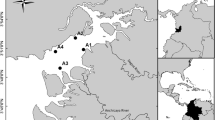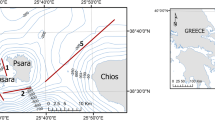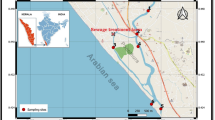Abstract
The fish assemblage of the Mondego estuary was studied from June 2003 to May 2004. Five areas with different environmental conditions were sampled monthly, using a 2 m beam trawl (5 mm mesh size at the cod end). To complement information, sampling was also performed, seasonally, using a 7 m otter trawl with a 10 mm mesh size. Thirty-two species were identified. Dicentrarchus labrax, Pomatoschistus microps, Pomatoschistus minutus, Solea solea, Platichthys flesus and Diplodus vulgaris were the most abundant species. Marine juvenile migrants had the highest number of species, thirteen, followed by estuarine residents with eight species. Marine species that use the estuary as nursery grounds were the most abundant in terms of density and biomass. In spring and summer, juveniles occur in the upper, oligohaline areas, but afterwards, in autumn and winter, they tend to disperse to the middle and lower areas, with higher marine influence. Comparing the results obtained in this study with those reported in the early 1990’s, a marked decrease in species richness can be noticed, which is probably due to anthropogenic factors, namely an increase in depth of the main channel and intense euthrophication processes in the middle and upper areas.




Similar content being viewed by others
References
Aprahamian, M. W. & C. D. Barr, 1985. The growth, abundance and diet of 0-group sea bass, Dicentrarchus labrax, from the Severn Estuary. Journal of the Marine Biological Association of the United Kingdom 65: 19–180.
Cardoso, P. G., A. Brandão, M. A. Pardal, D. Raffaelli & J. C. Marques, 2005. The resilience of Hydrobia ulvae populations to anthropogenic and natural disturbances. Marine Ecology Progress Series 289: 211–219.
Cardoso, P. G., M. A. Pardal, A. I. Lillebø, S. M. Ferreira, D. Raffaeli & J. C. Marques, 2004. Dynamic changes in seagrass assemblages under eutrophication and implications for recovery. Journal of Experimental Marine Biology and Ecology 302: 233–248.
Costa, M. J., P. R. Almeida, I. M. Domingos, J. L. Costa, M. J. Correia, M. L. Chaves & C. M. Teixeira, 2001. Present status of the main shad’s population in Portugal. Bulletin Français de la Pêche et de la Pisciculture 362: 1109–1116.
Costa, M. J. & H. N. Cabral, 1999. Changes in the Tagus nursery function for commercial fish species: some perspectives for management. Aquatic Ecology 33: 287–292.
Costa, M. J., C. I. Santos & H. N. Cabral, 2002. Comparative analysis of a temperate and tropical seagrass bed fish assemblages in two estuarine systems: the Mira estuary (Portugal) and the Mussulo lagoon (Angola). Cahiers de Biologie Marine 43: 73–81.
Elliott, M. & F. Dewailly, 1995. The structure and components of European estuarine fish assemblages. Netherlands Journal of Aquatic Ecology 29: 397–417.
Gordo, L. S. & H. N. Cabral, 2001. The fish assemblage structure of a hydrologically altered coastal lagoon: the Óbidos lagoon (Portugal). Hydrobiologia 459: 125-133.
Haedrich, R. L., 1983. Estuarine Fishes. In Ketchum, B. (ed.), Ecosystems of the World. 26 Estuaries and Enclosed Seas. Elsevier, Amsterdam, 183–207.
Hemingway, K. L. & M. Elliott, 2002. Field Methods. In Elliott, M. & K. Hemingway (eds), Fishes in Estuaries. Blackwell Science, Iowa.
Henderson, R. A. & J. D. Hamilton, 1986. The status of fish populations in the Clyde estuary. Proceedings of the Royal Society of Edinburgh 90: 157–170.
Hull, S. C., 1987. Macroalgal mats and species abundance: a field experiment. Estuarine, Coastal and Shelf Science 25: 519–532.
Jennings, S., J. E. Lankaster, J. S. Ryland & S. E. Shackley, 1991. The age structure and growth dynamics of young-of-the-year bass, Dicentrarchus labrax, populations. Journal of the Marine Biological Association of the United Kingdom 71: 799-810.
Jorge, I., C. C. Monteiro & G. Lasserre, 2002. Fish Community of Mondego Estuary: Space-Temporal Organization. In Pardal, M. A., J. C. Marques & M. A. Graça (eds), Aquatic Ecology of the Mondego River Basin. Global Importance of Local Experience. Imprensa da Universidade de Coimbra, Coimbra.
Lillebø, A. I., M. A. Pardal & J. C. Marques, 1999. Population structure, dynamics and production of Hydrobia ulvae (Pennant) (Mollusca: Prosobranchia) along an eutrophication gradient in the Mondego estuary (Portugal). Acta Oecologica 20: 289–304.
Marchand, J., I. Codling, P. Drake, M. Elliott, L. Pihl & J. Rebelo, 2002. Environmental Quality of Estuaries. In Elliott, M. & K. Hemingway (eds), Fishes in Estuaries. Blackwell Science, Iowa.
Marques, J. C., M. A. Pardal, S. N. Nielsen & S. E. Jørgensen, 1997. Analysis of the properties of energy and biodiversity along an estuarine gradient of eutrophication. Ecological Modeling 102: 155–167.
Martins, I., M. A. Pardal, A. I. Lillebø, M. R. Flindt & J. C. Marques, 2001. Hydrodynamics as a major factor controlling the occurrence of green macroalgal blooms in a eutrophic estuary: a case study on the influence of precipitation and river management. Estuarine, Coastal and Shelf Science 52: 165–177.
Mathieson, S., A. Cattrijsse, M. J. Costa, P. Drake, M. Elliott, J. Gardner & J. Marchand, 2000. Fish assemblages of European tidal marshes: a comparison based on species, families and functional guilds. Marine Ecology Progress Series 204: 225–242.
McLusky, D. S., 1989. The estuarine ecosystem. Blackie, Glasgow.
Pardal, M. A., P. G. Cardoso, J. P. Sousa, J. C. Marques & D. Raffaelli, 2004. Assessing environmental quality: a novel approach. Marine Ecology Progress Series 267: 1–8.
Pardal, M. A., J. C. Marques, I. Metelo, A. I. Lillebø & M. R. Flindt, 2000. Impact of eutrophication on the life cycle, population dynamics and production of Amphitoe valida (Amphipoda) along an estuarine spatial gradient (Mondego estuary, Portugal). Marine Ecology Progress Series 196: 207–219.
Pihl, L., H. Wennhage & S. Nilsson, 1994. Fish assemblage structure in relation to macrophyts and filamentous epiphytes in shallow non-tidal rocky and soft bottom habitats. Environmental Biology of Fishes 39: 271–288.
Prista, N., R. P. Vasconcelos, M. J. Costa & H. Cabral, 2003. The demersal fish assemblage of the coastal area adjacent to the Tagus estuary (Portugal): relationships with environmental conditions. Oceanologica Acta 26: 525–536.
Raffaelli, D. G., S. Hull & H. Milne, 1989. Long-term changes in nutrients, weed mats and shorebirds in an estuarine system. Cahiers de Biologie Marine 30: 259–270.
Raffaelli, D. G., J. A. Raven & L. J. Poole, 1998. Ecological impacts of green macroalgal blooms. Oceanography Marine Biology: An Annual Review 36: 97–125.
Ter Braak, C. J. F. & P. Smilauer, 1998. CANOCO Reference Manual and User’s Guide to Canoco for Windows: software for Canonical Community Ordination (version 4). Microcomputer Power, Ithaca, New York.
Wharfe, J. R., S. R. Wilson & R. A. Dines, 1984. Observations on the fish populations of an East coast estuary. Marine Pollution Bulletin 15: 133–136.
Whitfield, A. K & M. Elliott, 2002. Fishes as indicators of environmental and ecological changes within estuaries: a review of progress and some suggestions for the future. Journal of Fish Biology 61: 229–250.
Zar, J., 1996. Biostatistical Analysis. 3rd edn. Prentice Hall, Englewood Cliffs, New Jersey.
Author information
Authors and Affiliations
Corresponding author
Rights and permissions
About this article
Cite this article
Leitão, R., Martinho, F., Cabral, H.N. et al. The fish assemblage of the Mondego estuary: composition, structure and trends over the past two decades. Hydrobiologia 587, 269–279 (2007). https://doi.org/10.1007/s10750-007-0688-4
Issue Date:
DOI: https://doi.org/10.1007/s10750-007-0688-4




